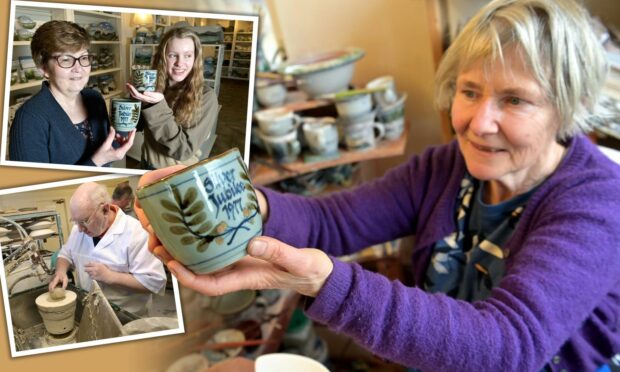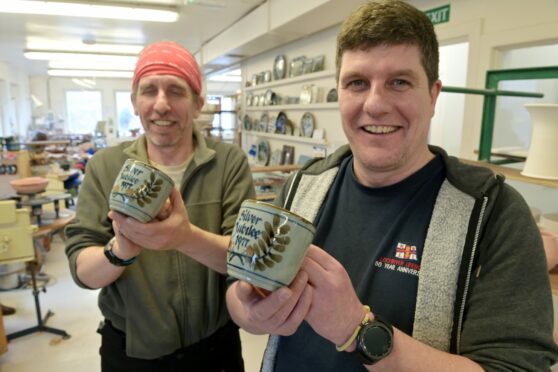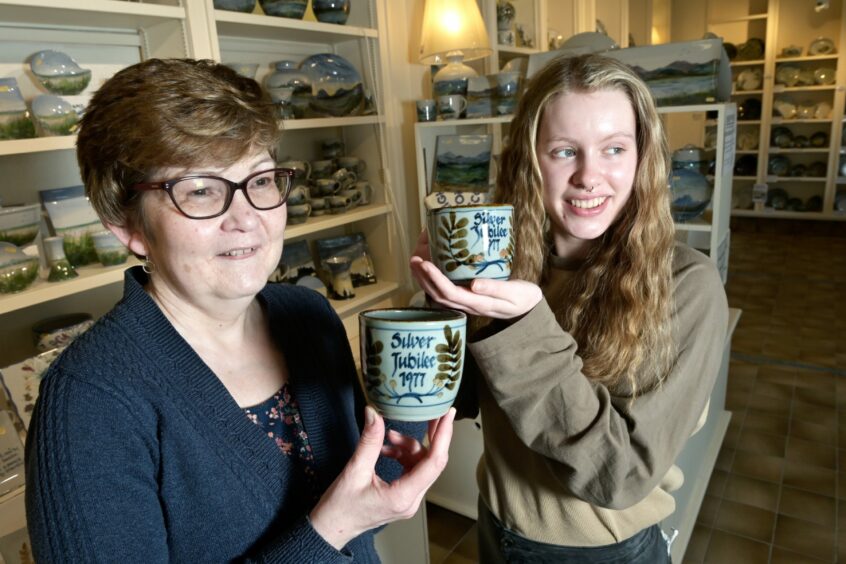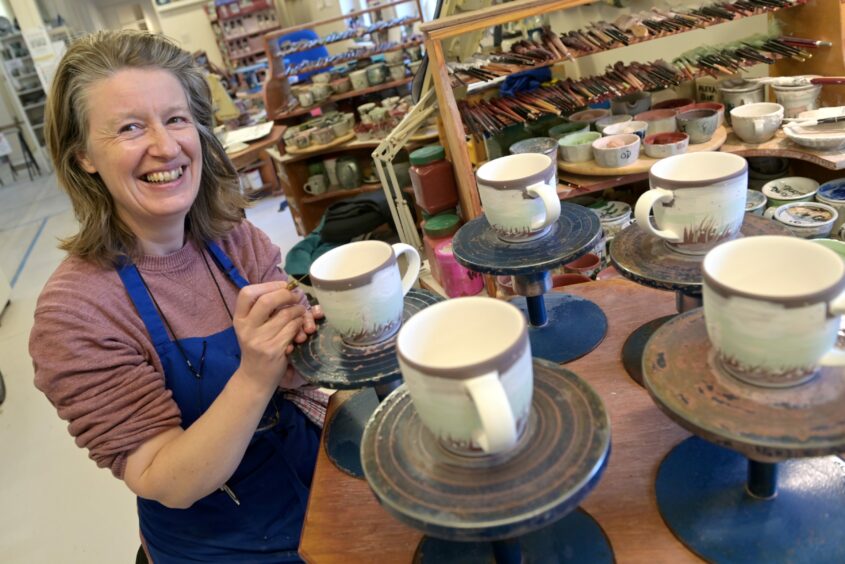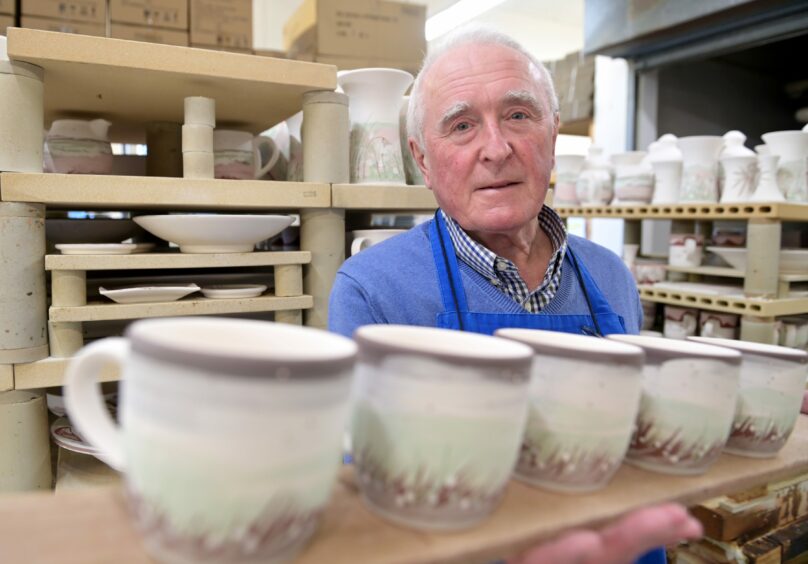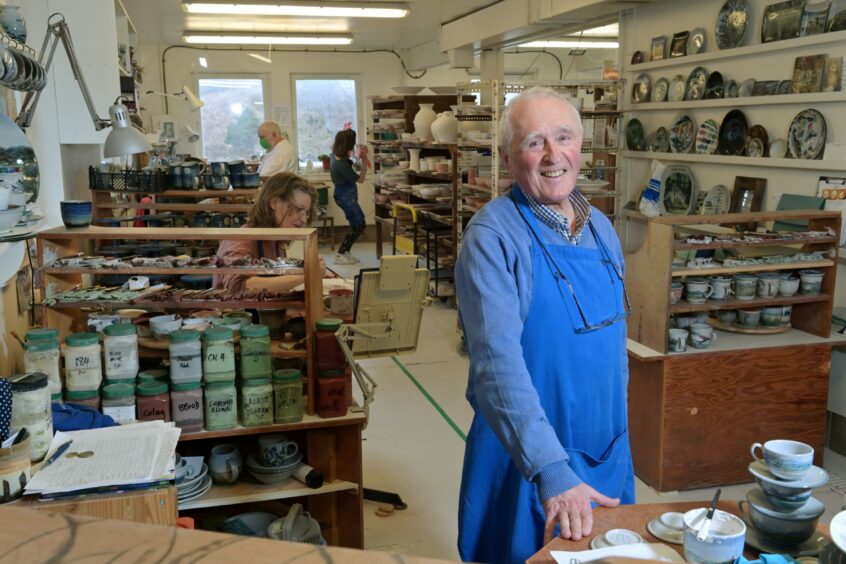In 1977 the Queen had been on the throne for 25 years, so a small business in Lochinver decided to do something to commemorate her Silver Jubilee.
Highland Stoneware, led by director David Grant, created a special Jubilee mug for each of the area’s 119 school children.
Now, in the Queen’s Platinum Jubilee year, some of the recipients, now middle-aged, have dusted off their mugs for another look.
They confess to not remembering much about the mugs or necessarily appreciating them at the time, but fortunately their parents did, and have kept them safe over the decades.
Some mugs have travelled with their owners to far-flung corners of the world; a few have met with accidents and are no more.
By now the recipients all have life stories, and for three 1977 youngsters, the Jubilee mugs lead straight back to Highland Stoneware.
Keeping the mug safe
James Pirie and Ewen and Murdo Aird each received Jubilee mugs, and are now married to three ladies currently working in the pottery.
James married ceramic artist Dorell, Ewen married designer/decorator Tracey and Murdo married Eileen, who deals with orders and helps in the office.
Murdo was 14 when he received the Jubilee mug.
Eileen said: “We have the mug in a cupboard, and Murdo said, ‘where did you get that from?’ and I said ‘it’s yours!’
“He couldn’t remember it.”
Catherine Nelson started working at the pottery two years ago.
Her mum Valerie got one of the mugs in 1977.
Catherine said: “My granny keeps it safe at her house.”
Gordon Kilgour was the potter who made the mugs, using a process called jigger and jolley, with plaster moulds and metal profiles.
He’s retired now, but kindly came to Highland Stoneware to demonstrate how he made the mugs in the video below.
The moulds are still used today, as the pleasing round shape is still one of customers’ favourites.
Linda Macleod was involved in painting the 1977 mugs.
She said: “It’s such a nice mug to drink from, it’s the original old-fashioned mug.
“We have one at home, my daughter reminded me, but we couldn’t find it, including on a high shelf where we keep things we don’t want broken.
“It’s possible it has been broken and someone didn’t want us to find the pieces.”
Linda started at the pottery in 1976, doing a bit of everything along with everyone at the time as the business got on its feet.
Creating Highland Stoneware
She said: “There wasn’t a lot of decorating done when I arrived, but it grew from there.
“David (Grant) developed the colours and shapes which are pretty special.
“It was a special and nurturing place to be and to learn in.”
Linda, who trained at Duncan of Jordanstone, created some of the pottery’s enduring and influential designs featuring cockerels, hens, birds and flowers, including honeysuckle and snowdrops.
“We have a free hand and if you have an idea you can work on things and if they sell, you paint more of them, and if they don’t, you drop it.
“I’m not in very much now, but it’s still a wonderful place to work.”
Highland Stoneware was founded in 1975 with David Grant, Grahame Clarke and Professor David Queensberry as directors.
David, from Achfary at the foot of Loch More, was 25 and had just gained his degree in ceramics at the Royal College of Art, where Grahame was his tutor and David, Lord Queensberry his professor.
He had already received his thorough grounding in the art and craft of pottery between 1966 and 1971 at Duncan of Jordanstone College of Art in Dundee, where he met not only his future wife Norah, but also a number of friends who would go on to help getting the pottery established.
He applied to the then-Highlands and Islands Development Board to help with his enterprise, and Highland Stoneware, with 15 to 20 employees, and more in the Ullapool shop, is now one of Lochinver’s biggest employers, after the near-demise of fishing.
It was David who created the unique formula and glaze for the stoneware.
Every item is still hand-painted, making each product also unique.
David’s vision for the pottery was deferred when he won a place at the Royal College of Art in London, but he cracked on with his ‘Stoneware Project’ while there, living out of a Dormobile he parked in a friend’s garden in Clapham.
Lord Queensberry backed him to the hilt, inviting buyers in leading stores to come and see the wares.
Market testing went well, the cash was raised, the site was found in Lochinver—and the rest is a success story, as Highland Stoneware’s iconic forms, colours and designs continue to evolve and have made their way to homes and businesses all over the world.
It’s known the Queen is an avid admirer of the pottery’s work, having commissioned several large pieces, and with a Highland Stoneware tea service in use in Balmoral.
For her Platinum Jubilee, David says there are plans afoot for some commemorative pieces, but for the moment, they’re still under wraps.
You might also like…
The Queen’s Platinum Jubilee Gifts & Collectables – Our Complete Guide
The Rover at 100: Beloved comic that thrilled readers before The Beano and The Dandy
